from ESCAPE INTO LIFE
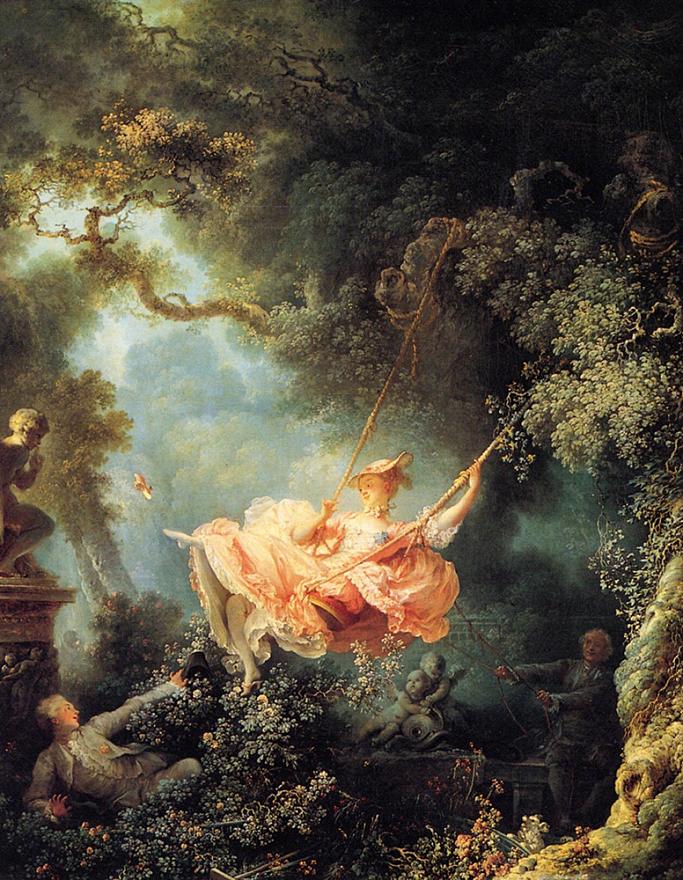
Jean-Honore Fragonard, The Swing
The three artists, Antoine Watteau (1684-1721), François Boucher (1703-1770) and Jean-Honoré Fragonard (1732-1806) define the French Rococo period spanning from the reign of Louis XIV “The Sun King” (1643-1715) to that of Napoleon Bonaparte (1804-1815). When one thinks of the Rococo, one immediately thinks of the decorative arts and ornamentation. If the Baroque was over the top in terms of style, Rococo paintings are often viewed as being even more frivolous, lighter, and immoral.
Synonymous with Rococo is the libertine and courtesan. We can see it as a transition period between the pious religious art of the early Louis Quartorze to the later “marble” severity of neoclassical art as exemplified by Jacques Louis David (1748-1825). It marked also a change in leisure pursuits as the countryside rather than the court became the locus for the ludic and erotic. We see this illustrated in Watteau’s famous fête galante paintings the plastic arts counterpart of the Italian commedia dell’arte.
Although Boucher had been tutored by Jean-Baptiste-Siméon Chardin (1699-1779) and adopted his Dutch realist-like brushwork, one sees more of the neo-classical in the late Fragonard. Both Watteau and Boucher had a lighter touch, and would delineate portraits with few strokes that place their art, particularly their drawings in the modernist idiom of reduction. In the case of Watteau, like some of the impressionists, his portraiture was very much decorative, verging on the caricature as in the work the English painter and graphic artist William Hogarth (1697-1764). But Hogarth was foremost a social critic and satirist, while the three French artists were commissioned by the court and its circle.
The demands of these aristocratic patrons and buyers could be very exacting, and one should be mindful of this context of patronage and its bearing on a composition. More than often the art had to match the decor of a room, perhaps work together rhetorically in conveying an aesthetic argument, and complement or compete with both existing art and recently commissioned art. Here the painting’s content might have to balance or contrast with the tenor and tone of the art in its immediate vicinity. If for example there was a preponderance of risqué paintings, then the buyer might wish for something to temper it morally. These conditions add to the decorative quality of the painting. One remarkable patron of the period was Madame de Pompadour, and her commissions helped shape the Rocco period.
Like the fan, the painting itself could be used to signal to another party feelings of love or loyalty, and in the case of the portrait be used in the games of seduction. Desire and seduction play an enormous part in the Rococo. To appreciate what happens in these paintings we must understand some of the rules. Despite widespread prostitution, and general debauchery, the aristocrat and the middle-class person had to follow strict rules regarding courtship and display of affection. Much of the seduction was circumlocutory. One never got to the point directly. As it has been said of Laurence Sterne’s The Sentimental Journey, the eroticism was “suspended.” Having said that, Boucher and Fragonard pushed the limits of propriety, thus incurring the wrath of the art critics.
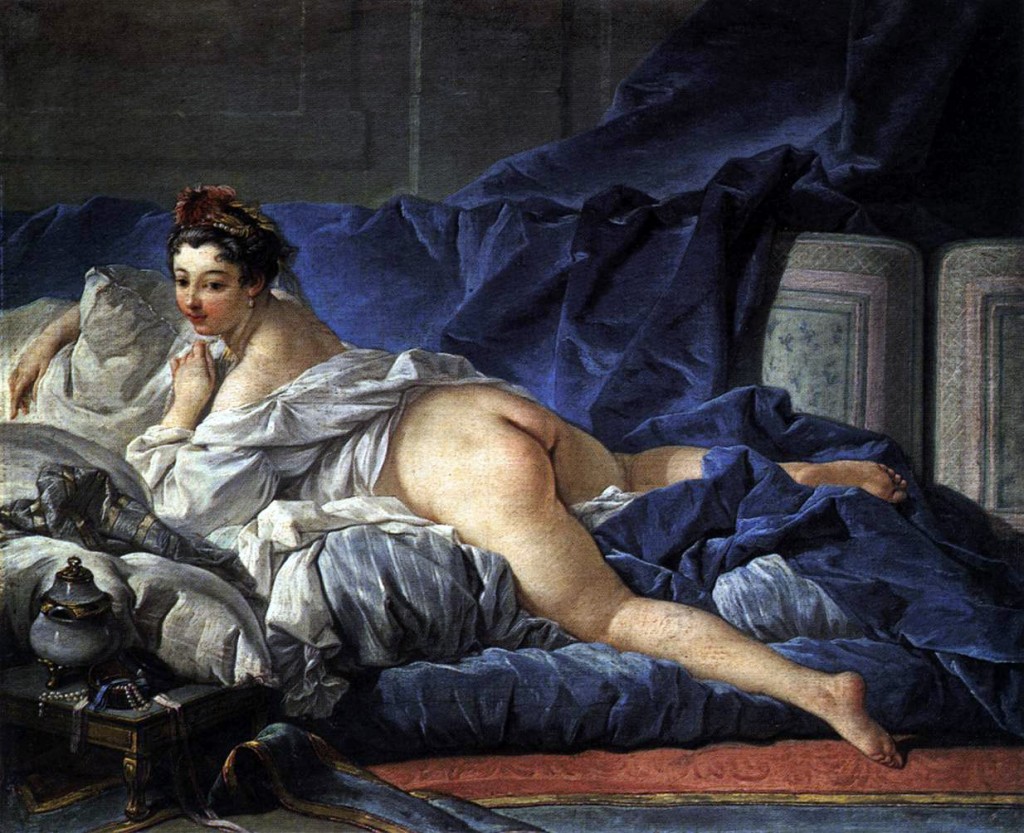
François Boucher, L’Odalisque (circa 1745)
If we look at the two odalisque paintings we can see some of the codes. In the so-called brunette odalisque, L’odalisque (1745?), a painting of his wife, Boucher has deliberately emphasized the Oriental theme. The word “odalisque” means a female slave or concubine in a harem, but here the pose is of an aristocrat upon a luxurious sofa. The variation on turquoise is brilliant. The nude with brunette hair looks like the young Turkish women who were then fantasized about, Orientalism then in vogue. What is interesting, and important to note, that although naked, she does not stare directly at the viewer, it is more downward.
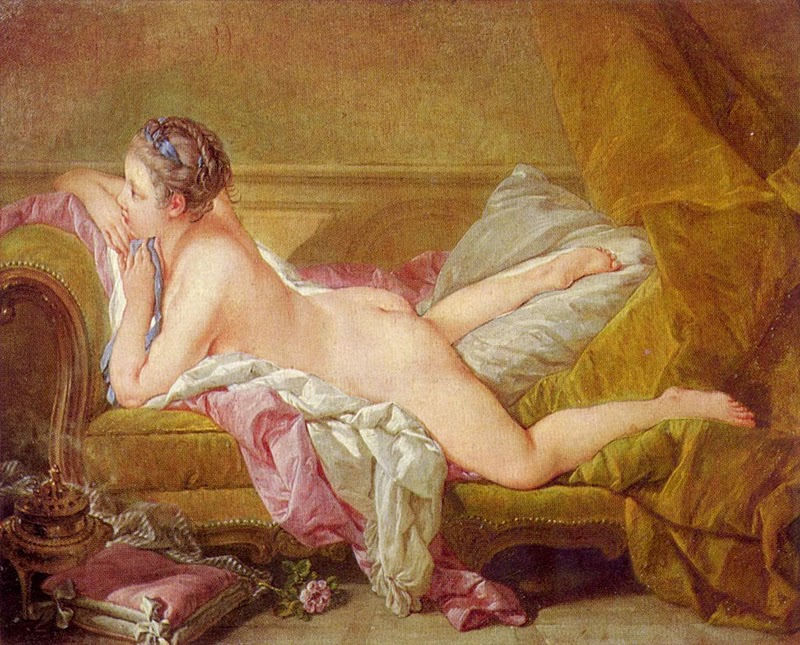
François Boucher, Blond Odalisque (1752)
When we look at Blond Odalisque, a commissioned painting of Marie-Louise O’Murphy (1752c), Louis XV’s mistress, we see that she is obviously European. The tones are flesh colour, modulated to give form and feature to the body, whereas in the first painting the blue gives a marblish appearance to the painting. The second painting is more decorative, the model seems much younger, even babyish, whereas in the brunette painting the viewer feels the sensuous and tactile quality of the fabrics.
We can also see that in the painter’s odalisques there is an aesthetic dialogue between the body and the material. In Renaissance paintings, though artists were successful in drawing anatomy, they did not manage as Boucher does, to convey the sensation of pressure. Despite the princess look of the brunette odalisque, her posture is of availability. Her bottom is almost dead centre of the lines of perspective!
Indeed this posture is the one found in an important erotic subgenre of the period, that of the woman awaiting an enema. In this subgenre the nude rests on a bed, and a maid or doctor waits to deliver an enema, the tell-tale clyster or syringe in their hand. This was an explicit pun on sexual intercourse, and perhaps even anal intercourse which was taboo. In both paintings the artist is careful to have the woman not looking directly at us.
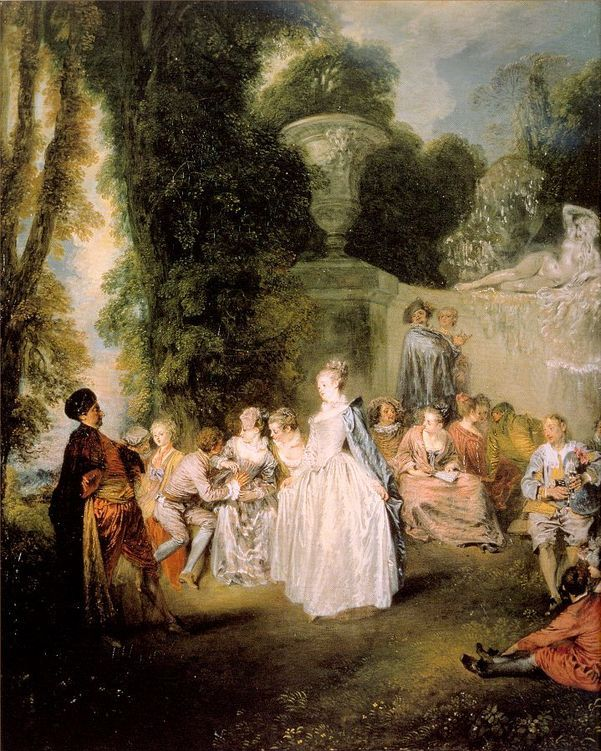
Antoine Watteau, Venetian Pleasure (1718)
Rococo art was heavily influenced by the dramatic arts, particularly theatre. The two enjoyed a symbiotic relationship since paintings required a plot and the theatre required decor and costumes. The painting Venetian Pleasure (1718) by Watteau is illustrative of this symbiosis. It shows the influence of the Italian dramatic forms which was very much in vogue at the time.
There is a lot going on in the painting, but first note the stylistic influence of Giovanni Battista Tiepolo (1696-1770) and perhaps Peter Paul Rubens (1577-1640) in the emphasis on colour rather than drawing, an important criterion in art. The faces of the women, as we move from one to the other, almost form an arabesque. Our focus, however, is on the central woman in dialogue with the actor dressed in an Oriental costume.
The painting has an operatic feel to it. The setting is theatrical rather than natural. Also note the orders of reality in this painting. There is the Venetian comic-theatrical world of the court, with aristocrats playing the parts, and the Greco-Roman classical world depicted by the statuary in the background. This contrast creates an aesthetic irony. Nearly everyone in the painting is courting; some more successful than others. We can see that often when a couple is in dialogue, a third party is looking at them, perhaps hurt or jealous.
This painting also illustrates the modernity of the period. The strict rules of depicting religion or the classical ideal have been broken. The social gathering is not much different from the groups of friends we find in nineteenth century paintings. Moreover, the statue of Venus that overlooks all the various lovemaking activities seems to be alive with erotic potential. The goat’s head on the large vase-like ornament directly above the central woman’s head is more sculptural and in keeping with classical mythology—this symbolic function is found in numerous Renaissance paintings. It connotes lust. This deliberate decision to make the nude statue alive is fascinating as it undermines the realist mimetic imperative, and simultaneously plays with the desires of the viewer. This is where the real dramatic tension rests, in the play of expectations.
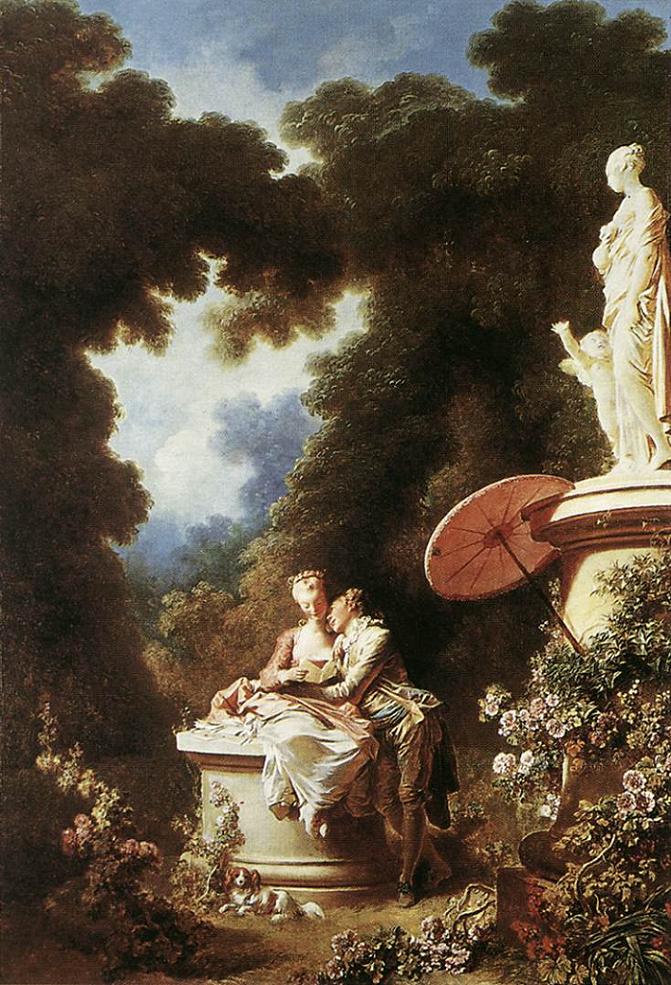
Jean-Honore Fragonard, The Confession of Love (1771)
Compare Watteau’s painting, particularly the sculpture of the goat’s head, with one by Fragonard, The Confession of Love (1771). Here we see that the woman is placed on a pedestal, literally—she is the art work, the tabeau vivant, and the confessor is taking more liberties in his affections than those in Watteau’s painting. The two sculptures, one of a putti (cupid) and another of a Goddess (Venus), are painted as if they were sculptures. They serve symbolic functions like the goat’s head in Watteau’s painting. The putti is in the form of a baby and the Goddess is its mother, suggesting that the end of courtship is marriage and children. However, the reaching for the apple also connotes carnality as in the Adam and Eve story. The dog placed at their feet is a double emblem. It can be both fidelity and a symbol of lust. Fragonard in another painting, Young Woman with Dog (1772), takes this latter element to an extreme, the dog becomes the actual object of lust—and according to some accounts, bestiality was not uncommon among aristocratic women. The landscape is also more “real,” aspiring to the Dutch landscape ideal, such as that found in the art of Jacob van Ruisdael (1628-1682).
This realism is counterpointed and even destabilized by the oval framing of the central figures by floral decor, a framing that reminds one of the flora decors on Rococo interior decor and in book plates. Perhaps it also prefigures the staging in Victorian photography where sitters were placed in ornate sets. We see in the painting how Fragonard managed to paint and remain current during the late Rococo into the neoclassical period. The statue has all the stiffness of a woman painted by Jacques-Louis David (1748-1825).
 I was born in London in 1956. I studied art at Herefordshire College, later went to UEA and studied literature. I worked abroad then came back to do a law degree. I have had poetry published in New Poetry, Snakeskin, Dada, Pif etc. I am a researcher in zoosemiotics based in Denmark.
I was born in London in 1956. I studied art at Herefordshire College, later went to UEA and studied literature. I worked abroad then came back to do a law degree. I have had poetry published in New Poetry, Snakeskin, Dada, Pif etc. I am a researcher in zoosemiotics based in Denmark.










No hay comentarios:
Publicar un comentario